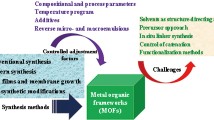Abstract
Originated from the pore space segmentation modification of a reported metal–organic framework (MOF) (NOTT-125), a new porous MOF ZnX was obtained and characterized by single-crystal X-ray diffraction, elemental analysis, X-ray powder diffraction and TGA. The ZnX exhibits remarkable selective CO2 adsorption property compared with that of the NOTT-125, which should be attributed to the enhanced gas-framework interactions induced by the fragmented pore space in ZnX.
摘要
基于对一例已报道的金属-有机框架材料(NOTT-125)的孔道空间分割修饰,本文获得了一例新的多孔金属有机框架ZnX,并利用单晶X射线衍射,元素分析,X射线粉末衍射和热重对其进行了表征研究。性质研究表明,孔道分割修饰增**了ZnX中气体与框架间的相互作用,使得其相比于NOTT-125展现出更好的CO2选择性吸附性质。



Similar content being viewed by others
References
Service RF (2004) Choosing a CO2 separation technology. Science 305:963
Sumida K, Rogow DL, Mason JA et al (2012) Carbon dioxide capture in metal–organic frameworks. Chem Rev 112:724–781
Petit JR, Jouzel J, Raynaud D et al (1999) Climate and atmospheric history of the past 420,000 years from the Vostok ice core, Antarctica. Nature 399:429–436
Nugent P, Belmabkhout Y, Burd SD et al (2013) Porous materials with optimal adsorption thermodynamics and kinetics for CO2 separation. Nature 495:80–84
Haszeldine RS (2009) Carbon capture and storage: how green can black be? Science 325:1647–1652
Christopher WJ, Edward JM (2010) Materials and processes for carbon capture and sequestration. ChemSusChem 3:863–864
Rubin ES, Mantripragada H, Marks A et al (2012) The outlook for improved carbon capture technology. Prog Energy Combust Sci 38:630–671
Bourrelly S, Llewellyn PL, Serre C et al (2005) Different adsorption behaviors of methane and carbon dioxide in the isotypic nanoporous metal terephthalates MIL-53 and MIL-47. J Am Chem Soc 127:13519–13521
Ramsahye NA, Maurin G, Bourrelly S et al (2007) Probing the adsorption sites for CO2 in metal organic frameworks materials MIL-53 (Al, Cr) and MIL-47 (V) by density functional theory. J Phys Chem C 112:514–520
Li B, Wang H, Chen B (2014) Microporous metal–organic frameworks for gas separation. Chem Asian J 9:1474–1498
Lu W, Sculley JP, Yuan D et al (2012) Polyamine-tethered porous polymer networks for carbon dioxide capture from flue gas. Angew Chem Int Ed 51:7480–7484
Himeno S, Toshiya Komatsu A, Fujita S (2005) High-pressure adsorption equilibria of methane and carbon dioxide on several activated carbons. J Chem Eng Data 50:369–376
Sevilla M, Fuertes AB (2012) CO2 adsorption by activated templated carbons. J Colloid Interface Sci 366:147–154
Zhao X, Bu X, Zhai QG et al (2015) Pore space partition by symmetry-matching regulated ligand insertion and dramatic tuning on carbon dioxide uptake. J Am Chem Soc 137:1396–1399
Zheng ST, Bu JT, Li Y et al (2010) Pore space partition and charge separation in cage-within-cage indium−organic frameworks with high CO2 uptake. J Am Chem Soc 132:17062–17064
Zheng ST, Mao C, Wu T et al (2012) Generalized synthesis of zeolite-type metal–organic frameworks encapsulating immobilized transition-metal clusters. J Am Chem Soc 134:11936–11939
Bu F, Lin Q, Zhai Q et al (2012) Two zeolite-type frameworks in one metal–organic framework with Zn24@Zn104 cube-in-sodalite architecture. Angew Chem 51:8538–8541
Wang H, Xu J, Zhang DS et al (2015) Crystalline capsules: metal–organic frameworks locked by size-matching ligand bolts. Angew Chem 54:5966–5970
Alsmail NH, Suyetin M, Yan Y et al (2008) Analysis of high and selective uptake of CO2 in an oxamide-containing {Cu2(OOCR)4}-based metal–organic framework. Chem Eur J 1085:7317–7324
Wang Z, Zheng B, Liu H et al (2013) High-capacity gas storage by a microporous oxalamide-functionalized NbO-Type metal–organic framework. Cryst Growth Des 13:5001–5006
Bureekaew S, Amirjalayer S, Schmid R (2012) Orbital directing effects in copper and zinc based paddle-wheel metal organic frameworks: the origin of flexibility. J Mater Chem 22:10249–10254
Dietzel PDC, Besikiotis V, Blom R (2009) Application of metal–organic frameworks with coordinatively unsaturated metal sites in storage and separation of methane and carbon dioxide. J Mater Chem 19:7362–7370
Kim J (2011) Control of catenation in CuTATB-n metal–organic frameworks by sonochemical synthesis and its effect on CO2 adsorption. J Mater Chem 21:3070–3076
Wang B, Côté AP, Furukawa H et al (2008) Colossal cages in zeolitic imidazolate frameworks as selective carbon dioxide reservoirs. Nature 453:207–211
Mason JA, Sumida K, Herm ZR et al (2011) Evaluating metal–organic frameworks for post-combustion carbon dioxide capture via temperature swing adsorption. Energy Environ Sci 4:3030–3040
Acknowledgments
This work was supported by the National Natural Science Foundation of China (21531005, 21421001, and 21290171) and Ministry of Education Innovation Team of China (IRT13022).
Author information
Authors and Affiliations
Corresponding authors
Ethics declarations
Conflict of interest
The authors declare that they have no conflict of interest.
Electronic supplementary material
Below is the link to the electronic supplementary material.
About this article
Cite this article
Fu, D., Xu, Y., Zhao, M. et al. Enhancement of gas-framework interaction in a metal–organic framework by cavity modification. Sci. Bull. 61, 1255–1259 (2016). https://doi.org/10.1007/s11434-016-1133-8
Received:
Revised:
Accepted:
Published:
Issue Date:
DOI: https://doi.org/10.1007/s11434-016-1133-8




